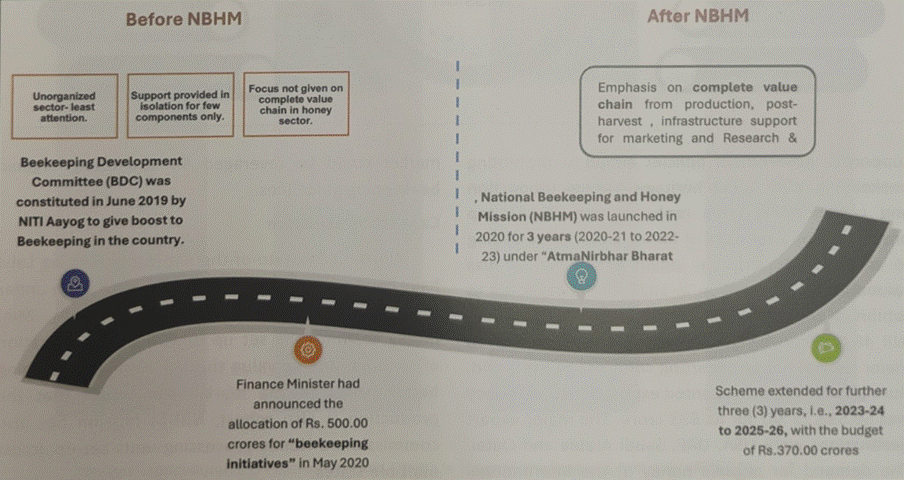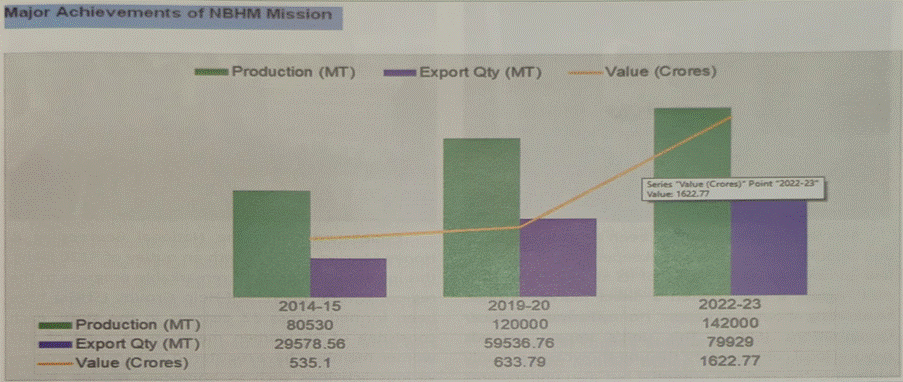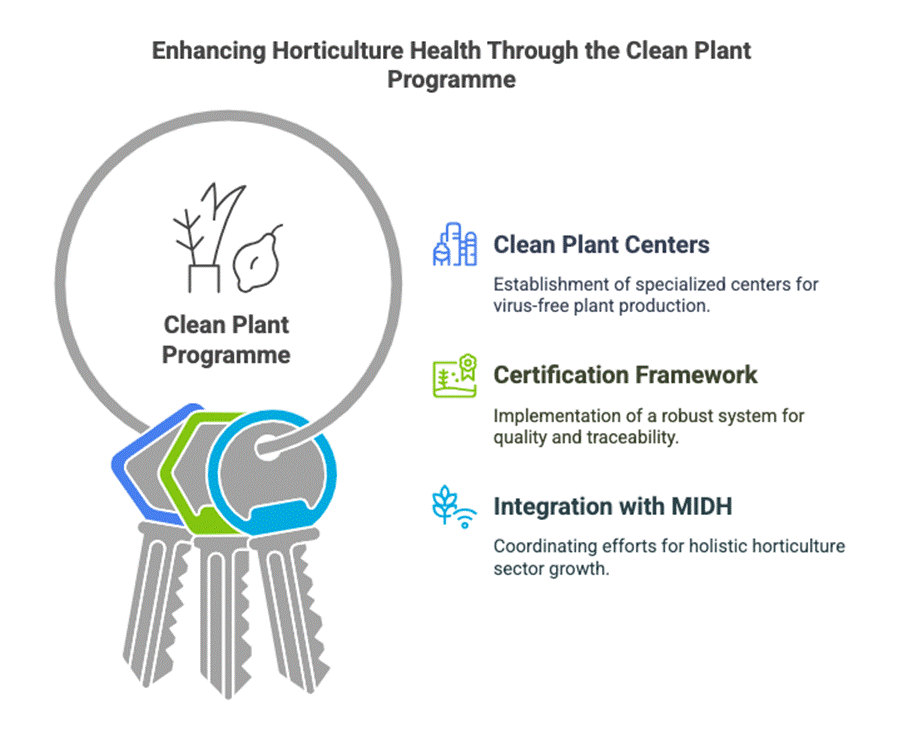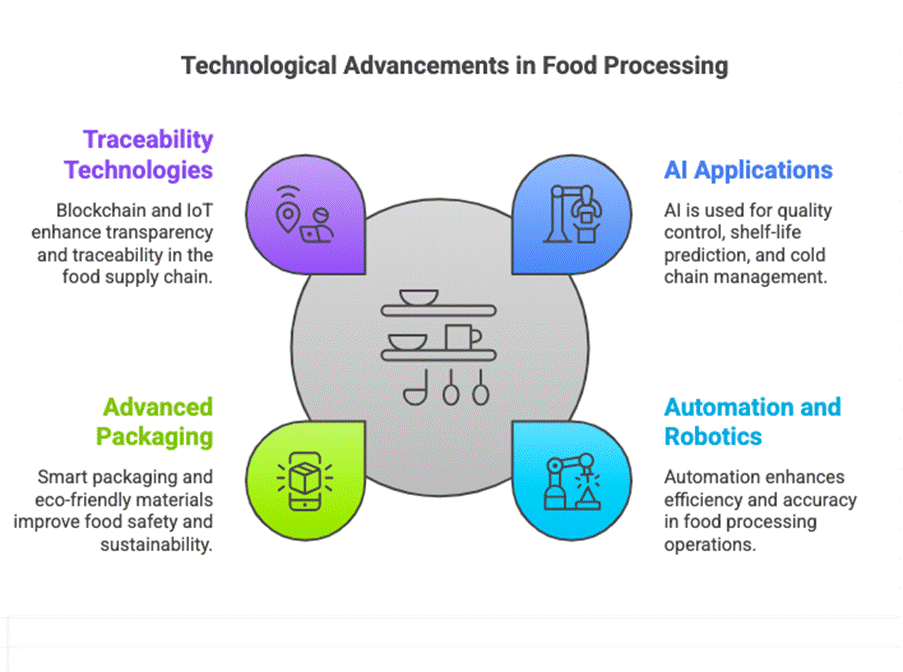Kurukshetra Summary: February 2025 – Horticulture For Prosperity
1. Fruit-Based Farming Systems for Improved Income and Livelihood
- 1. Fruit-Based Farming Systems for Improved Income and Livelihood
- 2. Beekeeping: Generating Employment Opportunities
- 3. Clean Plant Programme: Revolutionizing Indian Horticulture
- 4. Food Processing of Horticultural Crops
- 5. Nutritional and Health Security through Horticulture
- 6. Sustaining Rural Livelihoods Through Horticulture
Introduction to Fruit-Based Farming Systems
- Fruit-based farming systems contribute to agricultural sustainability, economic resilience, and nutritional security in India.
- Government initiatives such as subsidies for irrigation and cold storage have supported fruit farming.
- India is the second-largest producer of fruits globally, with a production target of 244 million tonnes by 2047.
Key Fruits and Their Production
- Mango: India is the world’s largest producer of mangoes.
- Banana: Cultivation is extensive in Tamil Nadu, Maharashtra, and Andhra Pradesh.
- Lime and Lemon: Significant contributors to the fruit sector.
- Grapes: Industry has grown steadily due to advancements in post-harvest management.
- Custard Apple: Plays an essential role in India’s fruit production landscape.
Export Growth
- India’s fruit export sector has grown significantly.
- Mango exports: Reached $47.98 million between April and August 2023.
- Key destinations: The United States is a primary market for Indian mangoes.
- Expansion: India now exports fruits to 41 countries, including Iran, Mauritius, and Nigeria.
Benefits of Fruit-Based Farming
Economic Upliftment
- High-value fruit crops enhance farmers’ income.
- Contributes to foreign exchange reserves through exports.
Environmental Sustainability
- Mulching, contour farming, and crop rotation: Prevent soil erosion and enhance soil health.
- Agroforestry and mixed cropping: Improve biodiversity.
Health Benefits
- Fruits provide essential vitamins, minerals, and antioxidants for public health.
Livelihood Diversification
- Integrating fruit farming with other agricultural activities reduces dependency on a single crop.
- Generates additional income sources.
Scope and Opportunities
Drought-Tolerant Varieties
- Pomegranates, grapes, and date palms are ideal for arid regions.
Agroforestry and Mixed Cropping
- Integrating fruit trees with crops and livestock enhances soil health and biodiversity.
Horticulture Tourism
- Promotes sustainable agriculture and boosts farmers’ income.
- Attracts tourists to fruit farms for agritourism experiences.
Protected Cultivation
- High-value fruits like strawberries and dragon fruit thrive in polyhouses and greenhouses.
Key Components for Success
- Crop Selection and Zoning: Choosing appropriate fruit crops based on agro-climatic conditions.
- Quality Planting Materials: Ensuring access to disease-free, genetically superior planting material.
- Research and Development: Investing in high-yield and climate-resilient fruit varieties.
- Infrastructure Development: Establishing pack houses, cold storage, and processing units to minimize post-harvest losses.
Challenges
- Land Fragmentation: Small landholdings limit scalability and adoption of modern agricultural techniques.
- Knowledge Gaps: Limited awareness of high-density planting and integrated pest management among farmers.
- High Initial Investment: Establishing fruit orchards requires significant capital, posing challenges for small farmers.
- Climate Vulnerability: Droughts, floods, and irregular rainfall patterns affect fruit crop yields.
Government Schemes
- National Horticulture Mission (NHM): Focuses on improving production, post-harvest management, and market access.
- Pradhan Mantri Krishi Sinchayee Yojana (PMKSY): Aims to enhance irrigation infrastructure for fruit farming.
- Mission for Integrated Development of Horticulture (MIDH): Provides comprehensive support for horticultural development.
Way Forward
- Public-Private Partnerships (PPPs): Promote technological advancements and infrastructure development.
- Farmer Producer Organizations (FPOs): Improve market access and eliminate intermediaries.
- Climate-Resilient Agriculture: Encourage sustainable farming techniques to counter climate change impacts.
Conclusion
- Fruit-based farming systems enhance economic growth, environmental sustainability, and nutritional security in India.
- Strengthening infrastructure, research, and climate-resilient practices can unlock the sector’s full potential for long-term agricultural prosperity.
2. Beekeeping: Generating Employment Opportunities
Historical Context
- Beekeeping has ancient roots, with honey being used for over 5,000 years.
- India is a major player in the global honey market, with diverse flora supporting various honey types.
Migratory Beekeeping in India
- Beekeepers relocate colonies based on floral resources, moving between plains and hilly regions.
- Key regions include Uttaranchal, Uttar Pradesh, Haryana, Punjab, and Rajasthan.
National Beekeeping and Honey Mission (NBHM)
- Launched in 2020 as part of the Atma Nirbhar Bharat initiative.
- Aims to promote scientific beekeeping, improve honey quality, and enhance infrastructure.
- Budget of Rs. 500 crores initially, extended to Rs. 370 crores for 2023-24 to 2025-26.

Honey Market in India
- The Indian honey market was valued at INR 25.2 billion in 2023, expected to reach INR 48.6 billion by 2032.
- Major export destinations include the USA, UAE, Saudi Arabia, and Qatar.
Key Achievements
- Production increased from 80,530 MT in 2014-15 to 142,000 MT in 2022-23.
- Exports grew from 29,578.56 MT in 2014-15 to 79,929 MT in 2022-23.

Digital Initiatives
- Madhukranti Portal: Launched in 2021 for traceability and registration of beehive products.
- Open Network for Digital Commerce (ONDC): Facilitates e-commerce for honey-based FPOs.
Policy Initiatives
- Minimum Export Price (MEP): Set at US$ 2,000 per metric tonne to safeguard the domestic honey industry.
- Quality Standards: FSSAI has established standards for honey, beeswax, and royal jelly.
| Success Stories |
|
Northeast India: M/s Salt Range Foods Acts as a key market link for local beekeepers and Honey Farmer Producer Organizations. Supports local industries and promotes sustainable economic growth. Highlights Northeast India’s potential in commercial beekeeping. Tamil Nadu: National Beekeeping & Honey Mission Empowered 887 women through 37 Self-Help Groups across 13 districts. Provides training in honeybee rearing, production, and nursery management. Enables income generation through honey sales, especially to tourists. High-Altitude Regions: Scientific Beekeeping Expansion Promotes high-value honey varieties like Acacia and Wild Ajwain. Conducts training for master trainers to improve scientific beekeeping knowledge. Establishes mini testing labs for quality control and product standardization. |
Future Roadmap
- Focus on value-added products like beeswax, pollen, propolis, and royal jelly.
- Geographical indication (GI) tagging and chemical fingerprinting to enhance honey quality and marketability.
Conclusion
- India’s beekeeping sector is expanding with scientific advancements, digital initiatives, and strong policy support.
- Future growth will focus on value addition, quality enhancement, and global market competitiveness.
3. Clean Plant Programme: Revolutionizing Indian Horticulture
Introduction
- India is the second-largest producer of fresh fruits and vegetables globally, holding immense potential to meet both domestic and international demand.
- Despite this potential, the horticulture sector faces challenges such as low crop quality, limited productivity, and sustainability concerns.
Clean Plant Programme (CPP)
- To address these issues, the Indian government launched the Clean Plant Programme (CPP) in 2024 with an investment of Rs. 1,765.67 crore.
- The CPP aims to provide farmers with virus-free, high-quality planting material to enhance productivity and competitiveness in the agricultural market.
Objectives of the Clean Plant Programme (CPP)
- Improve Planting Material Quality: Provide disease-free planting material to boost crop yields, minimize losses, and improve the quality of horticultural produce.
- Establish Clean Plant Centers: Set up nine state-of-the-art Clean Plant Centers across India, equipped with advanced diagnostic and therapeutic facilities.
- Develop Region-Specific Varieties: Focus on producing region-specific clean plant varieties to help farmers adapt to local environmental challenges.
Benefits of the Clean Plant Programme
- For Farmers: Increased crop yields, reduced losses, and improved income due to better-quality produce.
- For Nurseries: Streamlined certification processes, infrastructure support, and higher demand for high-quality plants.
- For Consumers: Availability of superior produce with better taste, appearance, and nutritional value.
- For Export Market: Strengthened global export position due to improved quality and disease-free certification, enhancing India’s share in the international market.
Core Components of the Clean Plant Programme

Inclusivity and Sustainability
- Affordable Access: Ensuring small-scale and marginalized farmers have access to high-quality planting material.
- Empowering Women Farmers: Encouraging female participation in horticulture through targeted support mechanisms.
- Region-Specific Approach: Addressing diverse agro-climatic conditions across India to maximize the effectiveness of the programme.
Synergy with Environmental Initiatives
- Alignment with Mission LIFE: Promoting sustainable farming practices that align with India’s broader environmental goals.
- One Health Approach: Reducing reliance on harmful chemicals and ensuring a holistic approach to agricultural sustainability.
Implementation and Oversight
- The National Horticulture Board (NHB), in collaboration with the Indian Council of Agricultural Research (ICAR), will oversee the programme’s implementation.
- This partnership will ensure efficient execution, leveraging research expertise to maximize impact.
Conclusion
- The Clean Plant Programme is a transformative initiative aimed at improving the quality, productivity, and sustainability of India’s horticulture sector.
4. Food Processing of Horticultural Crops
Introduction
- Food processing plays a crucial role in food and nutrition security, especially in a country like India with a vast and diverse population.
- It involves converting raw food into consumable or durable forms, ensuring preservation, safety, and enhanced nutritional value.
Food Processing in India
- India is the second-largest producer of fruits and vegetables globally but faces high post-harvest losses due to the short shelf life of these commodities.
- Studies estimate losses between:
- 6.7-15.8% for fruits
- 4.5-12.4% for vegetables
- These losses translate into significant economic setbacks and occur at various stages:
- Storage
- Packaging
- Transportation
- Marketing
- Food processing is essential to minimize these losses, improve nutrient retention, and ensure food quality.
Global Market and Potential
- The global market for fruit and vegetable ingredients is expanding, with developed nations importing a significant portion of their food.
- India’s food processing sector is growing, contributing to exports and employment.
- However, processing levels in India remain low compared to global standards.
- There is huge potential for India to increase its share in the global processed food market, particularly in high-value and value-added products.
Emerging Technologies in Food Processing
- Modern technologies are revolutionizing food processing, improving efficiency, quality, and safety.
- Non-Thermal Technologies:
- High-Pressure Processing (HPP): Preserves food without compromising nutritional and sensory qualities.
- Cold Plasma Technology: Reduces microbial contamination while maintaining food quality.
- Pulsed Electric Field (PEF) Technology: Enhances shelf life and nutrient preservation.
- These technologies offer advantages such as:
- Increased shelf life
- Better microbial control
- Minimal impact on nutritional value
Food Fortification: Addressing Micronutrient Deficiencies
- Food fortification is a key strategy to combat micronutrient deficiencies in India.
- It involves adding essential vitamins and minerals to staple foods.
- Particularly relevant in India, where deficiencies in iron, iodine, and vitamin A are common.
Role of Technology in Food Processing

Government Initiatives Supporting Food Processing
- The Indian government has launched various schemes and policies to boost the food processing sector.
- Pradhan Mantri Kisan SAMPADA Yojana (PMKSY):
- Focuses on modern infrastructure, financial aid, and sector formalization.
- PM Formalisation of Micro Food Processing Enterprises (PMFME) Scheme:
- Supports small food processing enterprises with funding and training.
| Success Stories in India’s Food Processing Industry |
| Several companies have made significant contributions to the food processing industry:Amul: Revolutionized India’s dairy sector.PepsiCo: Invested in fruit processing and sustainable practices.ITC: Developed an extensive processed food range. |
Way Forward: Strengthening India’s Food Processing Sector
- The food processing industry in India has immense growth potential.
- Key recommendations for future growth:
- Stronger collaboration between research institutions, industry, and government to drive innovation.
- Encouraging investment in modern food processing technologies.
- Expanding cold storage and logistics infrastructure to reduce post-harvest losses.
- Promoting exports of processed food products to increase India’s global market share.
Conclusion
- Food processing is vital for reducing post-harvest losses, ensuring food security, and boosting economic growth.
- With technological advancements, government support, and increased investment, India can enhance its food processing sector and become a global leader in the industry.
5. Nutritional and Health Security through Horticulture
Introduction
- Malnutrition remains a major public health challenge in India despite various initiatives.
- The Global Hunger Index highlights that one in three children in India has stunted growth, and 15% of the population is undernourished.
- Addressing malnutrition requires a comprehensive approach that ensures nutritional security.
- Horticulture plays a crucial role in providing essential nutrients and promoting overall health.
Horticulture for Nutritional Security
- Horticultural crops such as fruits, vegetables, and nuts are rich in vitamins, minerals, antioxidants, folic acid, and dietary fiber.
- These crops contribute to the nutritional well-being of the population by enhancing dietary quality.
- Regular consumption of horticultural crops can help prevent nutrient deficiencies and chronic diseases.
Food Security vs. Nutritional Security
- Food security focuses on adequate food production and availability.
- Nutritional security includes:
- Biological utilization of food by the body.
- Safe and diverse diets with essential nutrients.
- Non-food factors like water, sanitation, and healthcare practices.
- Achieving nutritional security requires a shift from focusing solely on food grain production to ensuring access to nutritious and safe food.
Horticulture Production in India
- India has significantly increased horticulture production, reaching 353.19 million tonnes in 2023-2024.
- This growth in production presents an opportunity to enhance food diversity and combat malnutrition.
- Encouraging the cultivation and consumption of horticultural crops can bridge nutritional gaps in the Indian diet.
Dietary Recommendations
- The ICMR-NIN dietary guidelines recommend:
- 400 grams of vegetables daily.
- 100 grams of fruits daily.
- Consuming a variety of horticultural crops ensures adequate intake of essential nutrients and promotes better health.
Nutritional Value of Horticultural Crops
- Horticultural crops are rich sources of:
- Dietary fiber (aids digestion and prevents obesity).
- Vitamins and minerals (boosts immunity and prevents deficiencies).
- Bioactive compounds (provides additional health benefits).
- These crops are low in calories and fat, making them an integral part of a healthy and balanced diet.
Micronutrient Deficiencies in India

Nutraceuticals: Health Benefits Beyond Nutrition
- Horticultural crops contain nutraceuticals – bioactive compounds that provide health benefits beyond basic nutrition.
- These compounds have antioxidant and anti-inflammatory properties that help in:
- Reducing the risk of chronic diseases like cancer and cardiovascular disorders.
- Boosting the immune system and improving overall well-being.
Improved Varieties of Horticultural Crops
- Research and development efforts have led to the development of nutrient-rich crop varieties.
- These varieties help in enhancing dietary intake and improving public health outcomes.
- Examples include high-iron spinach, vitamin A-rich carrots, and biofortified staple crops.
Mushrooms: A Growing Industry for Nutritional Security
- Mushrooms are an emerging food source with high nutritional value.
- They are rich in proteins, vitamins, and minerals.
- Economic and environmental benefits:
- Can be cultivated using agricultural waste, reducing food production costs.
- Provide employment opportunities in rural and urban areas.
Biofortification: Enhancing Nutritional Content
- Biofortification involves breeding crops with higher levels of essential nutrients.
- Key initiatives include:
- Iron-enriched beans and rice.
- Vitamin A-rich sweet potatoes and maize.
- Zinc-enriched wheat and rice.
- These initiatives help in addressing hidden hunger and micronutrient deficiencies.
Nutritional Gardens: A Sustainable Approach
- Nutritional gardens promote homegrown fruits and vegetables for better dietary intake.
- Benefits include:
- Improves household food security.
- Provides a cost-effective source of fresh, nutrient-rich food.
- Encourages sustainable agriculture and self-sufficiency in rural areas.
Horticulture Extension Programs
- Extension programs educate farmers on:
- Improved cultivation practices.
- The importance of nutrient-rich horticultural crops.
- These programs also promote local consumption of fresh fruits and vegetables.
- Increased awareness can lead to higher production and better nutritional outcomes.
Conclusion
- Malnutrition remains a challenge in India, but horticulture offers a viable solution to enhance nutritional security.
- Innovations such as biofortification, improved crop varieties, and nutraceuticals can further strengthen the role of horticulture in improving nutrition.
6. Sustaining Rural Livelihoods Through Horticulture
Rural Livelihoods and the Importance of Nature
- Rural areas are deeply connected to nature, offering a unique quality of life and ecological balance.
- Economic prosperity is often linked to urban areas, leading to large-scale migration from rural communities.
- Ensuring sustainable livelihoods in rural areas is essential for economic development, environmental conservation, and balanced urbanization.
Horticulture’s Role in Rural Development
- Horticulture involves the cultivation of fruits, vegetables, flowers, and other high-value crops.
- It provides significant opportunities for small and marginal farmers, as well as forest communities, to enhance their incomes.
- The sector supports sustainable agricultural practices and contributes to economic growth in rural areas.
- Diversification into horticulture can improve farm productivity, income levels, and market access for rural populations.
Potential of Horticulture in the Rural Economy
- Income Generation:
- Horticulture provides a reliable source of income for small and marginal farmers, reducing poverty levels in rural areas.
- High-value horticultural crops offer better returns compared to traditional cereals and pulses.
- Employment Opportunities:
- The horticulture sector generates employment across various activities, including cultivation, processing, packaging, and marketing.
- Women and youth can find sustainable livelihood opportunities in horticulture-related industries.
- Nutritional Security:
- Horticultural crops are rich in essential nutrients, helping to combat malnutrition and improve public health.
- Increased production and consumption of fruits and vegetables contribute to balanced diets and reduced micronutrient deficiencies.
- Environmental Sustainability:
- Horticultural practices promote soil conservation, efficient water management, and biodiversity conservation.
- Agroforestry and organic farming in horticulture can improve soil health and reduce chemical usage.
- Rural Tourism:
- Horticulture-based agritourism initiatives can attract visitors and generate additional income for rural communities.
- Agro-tourism helps preserve traditional farming practices while promoting cultural exchange.
Challenges for Livelihood Creation through Horticulture
- Insufficient Post-Harvest Infrastructure:
- Lack of adequate storage and processing facilities leads to significant post-harvest losses.
- Poor market linkages reduce profitability for farmers and hinder access to wider markets.
- Limited Access to Resources:
- Small farmers face difficulties in accessing quality seeds, efficient irrigation systems, and financial credit.
- Unequal distribution of resources prevents small-scale farmers from expanding horticulture operations.
- Climate Change Impacts:
- Extreme weather conditions, including droughts, floods, and unseasonal rains, affect horticultural yields.
- Climate-resilient horticulture techniques are needed to mitigate production risks.
- Market Volatility:
- Price fluctuations and market uncertainties create financial risks for farmers.
- Lack of organized marketing channels results in lower bargaining power for producers.
Role of the State in Horticulture Development
- Government intervention is essential for strengthening the horticulture sector and ensuring its sustainability.
- Various initiatives and schemes have been introduced to support horticulture development, such as:
- Mission for Integrated Development of Horticulture (MIDH) – Supports horticulture expansion and technological interventions.
- National Horticulture Mission (NHM) – Promotes holistic horticulture growth and infrastructure development.
- Horticulture Cluster Development Programme (CDP) – Aims to develop horticulture clusters for better productivity and market linkages.
- These schemes help enhance productivity, improve infrastructure, and provide financial support to farmers.
Way Forward for Strengthening Horticulture in Rural Areas
- Comprehensive Horticulture Policy:
- A national-level policy framework is needed to ensure quality standards and address sectoral challenges.
- Policy measures should focus on production, processing, marketing, and export strategies.
- Private Sector Involvement:
- Encouraging private sector investment in horticulture can bring advanced technology andexpertise.
- Public-private partnerships (PPPs) can help establish cold storage, supply chains, and export promotion initiatives.
- Supply Chain Management:
- Strengthening supply chain infrastructure, including cold storage and transportation, can reduce post-harvest losses.
- Farmer-producer organizations (FPOs) can help improve bargaining power and ensure better market access.
- Focus on Himalayan States:
- The Himalayan region has unique agro-climatic advantages for horticulture but requires specialized support.
- Investment in infrastructure, research, and cold-chain logistics is necessary to enhance horticulture production in these areas.
- Rural Contextual Planning:
- n
- frastructure development, skill-building initiatives, and agro-tourism can enhance rural livelihoods.
Conclusion
- Horticulture plays a crucial role in sustaining rural livelihoods by offering income generation, employment, and nutritional security.
- The sector has significant potential for economic growth, environmental sustainability, and rural tourism development.

